Related Research Articles

Hindu mythology is the body of myths attributed to, and espoused by, the adherents of the Hindu religion, found in Hindu texts such as the Vedas, the itihasa the Puranas, and mythological stories specific to a particular ethnolinguistic group like the Tamil Periya Puranam and Divya Prabandham, and the Mangal Kavya of Bengal. Hindu myths are also found in widely translated popular texts such as the fables of the Panchatantra and the Hitopadesha, as well as in Southeast Asian texts.
Kalki, also called Kalkin, is the prophesied tenth and final incarnation of the god Vishnu. He is described to appear in order to end the Kali Yuga, one of the four periods in the endless cycle of existence (Krita) in Vaishnava cosmology. The end of the Kali Yuga states this will usher in the new epoch of Satya Yuga in the cycle of existence, until the Mahapralaya.

Chaitanya Mahaprabhu, born Vishvambhara Mishra, was a 15th-century Indian Hindu saint from Bengal who was the founder of Gaudiya Vaishnavism, which considers him to be an incarnation of Krishna.
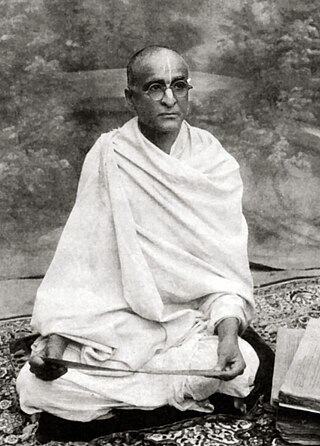
Bhaktisiddhanta Sarasvati, born Bimala Prasad Datt, was an Indian Gaudīya Vaisnava Hindu guru, ācārya, and revivalist in early twentieth-century India. To his followers, he was known as Srila Prabhupāda.

Gaudiya Vaishnavism, also known as Chaitanya Vaishnavism, is a Vaishnava Hindu religious movement inspired by Chaitanya Mahaprabhu (1486–1534) in India. "Gaudiya" refers to the Gaura or Gauḍa region of Bengal, with Vaishnavism meaning "the worship of Vishnu". Specifically, it is part of Krishnaism—Krishna-centric Vaishnavite traditions.

Bhaktivinoda Thakur, born Kedarnath Datta, was an Indian Hindu philosopher, guru and spiritual reformer of Gaudiya Vaishnavism who effected its resurgence in India in late 19th and early 20th century and was called by contemporary scholars as a Gaudiya Vaishnava leader of his time. He is also known along with his son Bhaktisiddhanta Sarasvati, with initiating the propagation of Gaudiya Vaishnavism in the West and its global spread.
Mayapur is a neighbourhood of Bamanpukur, in the Nabadwip CD block in the Krishnanagar Sadar subdivision of the Nadia district, West Bengal, India. It's situated at the confluence of the Jalangi River and the Bhagirathi, a tributary of the Ganges. The area is considered spiritually significant by followers of Gaudiya Vaishnavism.
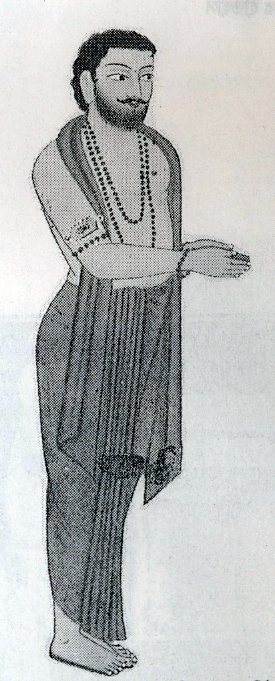
Rāmprasād Sen was a Hindu Shakta poet and saint of 18th-century Bengal. His bhakti poems, known as Ramprasadi, are still popular in Bengal—they are usually addressed to the Hindu goddess Kali and written in Bengali. Stories of Ramprasad's life typically include legends and myths mixed with biographical details.

Bengali Brahmins are the community of Hindu Brahmins, who traditionally reside in the Bengal region of the Indian subcontinent, currently comprising the Indian state of West Bengal and the country of Bangladesh.

Parīkṣit was a Kuru king who reigned during the Middle Vedic period. Along with his son and successor, Janamejaya, he played a decisive role in the consolidation of the Kuru state, the arrangement of Vedic hymns into collections, and the development of the orthodox srauta ritual, transforming the Kuru realm into the dominant political and cultural center of northern Iron Age India. He also appears as a figure in later legends and traditions. According to the legendary accounts in Mahabharata and the Puranas, he succeeded his grand uncle Yudhishthira to the throne of Hastinapura.
Śrī Caitanya-bhāgavata is a hagiography of Caitanya Mahāprabhu written by Vrindavana Dasa Thakura. It was the first full-length work regarding Chaitanya Mahaprabhu written in Bengali language and documents his early life and role as the founder of the Gaudiya Vaishnava tradition. The text details Chaitanya's theological position as a combined Avatar of both Radha and Krishna within the belief of his close associates and followers. The writing of Chaitanya Bhagavata was commissioned by Nityananda, who was the guru of Vrindavana Dasa Thakura and close friend of Chaitanya Mahaprabhu.
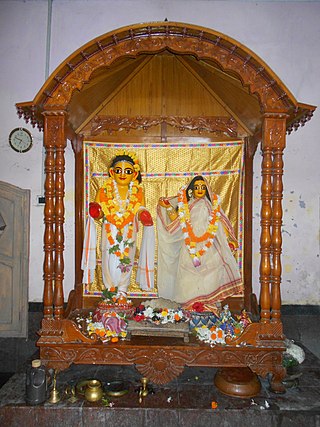
Advaita Acharya was a companion of the founder of the Gaudiya Vaishnava movement, Chaitanya Mahaprabhu, and guru of Haridasa Thakur. He was born in the village of Nabagram in Laud, in 1434, some fifty years before Chaitanya, and spent most of his adult life in the town of Shantipur in Nadia with his wife and family. Advaita Acharya had six sons, Acyutananda Das, Krisna Mishra, Gopala Das, Balarama Das Mishra, Swarupa Das and Jagadisa Mishra.
Ramai Pandit was a medieval Bengali poet from the Rarh region of Bengal. The exact date of his birth is not known, but some scholars believe that he was born in the later half of the 10th century and also lived in the 11th century AD, as he is a contemporary to Mayur Bhatt, the court-poet of King Lausen. Some scholars believe that he lived in the 13th or 14th century AD. He is famous as the author of Shunya Purana, the scripture of Dharma Puja Bidhan, written in the 11th century AD. The extant Shunya Purana refers to events that occurred in the 14th century.

Nabadwip, also spelt Navadwip, anciently Nadia or Nudiya, is a heritage city in Nadia district in the Indian state of West Bengal. It is regarded as a holy place by Hindus, and is the birthplace of Chaitanya Mahaprabhu. Famous for Rass festival where city is illuminated with lights, deities of God and goddesses are made on each corner of Nabadwip town. Hundreds of people gather to this small town on the occasion of raas utsab. Located on the western bank of the Hooghly River, it is considered to have been founded in 1063 CE, and served as the old capital of the Sena dynasty. A center of learning and philosophy in medieval India, the city is still noted for its traditional Sanskrit schools. The Navya Nyaya school of logic reached its peak with the efforts of some well known contemporary philosophers of Nabadwip. The great Vaishnava saint, social reformer and an important figure of the Bhakti movement, Chaitanya Mahaprabhu (1486–1534) was born here. It was after Chaitanya Mahaprabhu's birth that Nabadwip became an important center of pilgrimage for the Vaishnavas worldwide as well as for Hindus in general. Many who follow Gaudiya Vaishnavism visit Nabadwip to celebrate the auspicious birthday day of Shri Mahaprabhu, which, as per lunar calculations, occurs on Phalguni Purnima. This day is commonly known as Gaura-purnima. Aside from this, Nabadwip is visited for various other festivals like Dol Jatra and Rash purnima.
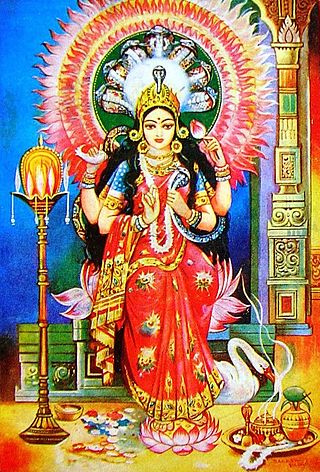
Mangal-Kāvya is a group of Bengali religious texts, composed more or less between 13th and 18th centuries, notably consisting of narratives of indigenous deities of rural Bengal in the social scenario of the Middle Ages. The Mangal-Kāvyas usually give prominence to a particular deity amalgamated with a Vedic or Hindu mythological god and the narratives are usually written in the form of verses.

Ala-ud-din Husain Shah (Bengali: আলাউদ্দিন হোসেন শাহ was an independent late medieval Sultan of Bengal, who founded the Hussain Shahi dynasty. He became the ruler of Bengal after assassinating the Abyssinian Sultan, Shams-ud-Din Muzaffar Shah, whom he had served under as wazir. After his death in 1519, his son Nusrat Shah succeeded him. The reigns of Husain Shah and Nusrat Shah are generally regarded as the "golden age" of the Bengal sultanate.
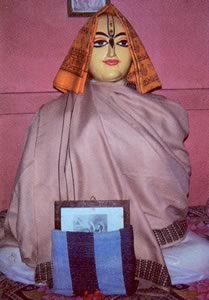
Haridasa Thakur was a Vaishnava saint known for playing a part in the initial propagation of the Hare Krishna movement. He is considered to be a known convert of Chaitanya Mahaprabhu, apart from Rupa Goswami and Sanatana Goswami. His story of integrity and faith in the face of adversity is told in Chaitanya Charitamrita, Antya lila. It is believed that Chaitanya Mahaprabhu himself designated Haridasa as nāmācarya, meaning the 'teacher of the Name'. Haridasa Thakura was a devotee of the deity Krishna, and is regarded to have practised the chant of his veneration, Hare Krishna, 300,000 times daily.

Hinduism is the largest religious tradition in the Indian state of West Bengal with approximately 70.53% of the population identifying themselves as Hindus. The Hindus in West Bengal mostly belong to the Shakta, minority to Vaishnavite and a small community belong to Shaivite and other denominations. The vast majority of Hindus in West Bengal are Bengali Hindus numbering around 55 million and comprising 60.2% of the state population of 91.35 million (2011) but a notable section of non-Bengali Hindus also exist, particularly among Marwaris, Biharis, Odias, Gurkhas, Sindhis, Gujaratis and various tribal communities such as Koch, Santals, Munda and particularly Adivadis numbering around 9.4 million comprising rest 10.3% of the state population.
Anthony Firingee, born as Hensman Anthony, was a Bengali language kavigan singer-writer and folk poet of Portuguese origin known for his works in Bengali devotional songs in the early part of the 19th century. He was also noted for his performance in literary face-offs known as Kavigan.

The Vaishnava Padavi movement refers to a period in medieval Bengali literature from the 15th to 17th centuries, marked by an efflorescence of Vaishnava poetry often focusing on the Radha-Krishna legend. The term padavali has the literal meaning "gathering of songs".
References
- ↑ "SECTION II.— DESCRIPTION OF CERTAIN FEATURES OF THE COUNTRY OF BENGAL". Archived from the original on 2011-12-28. Retrieved 2009-03-23.